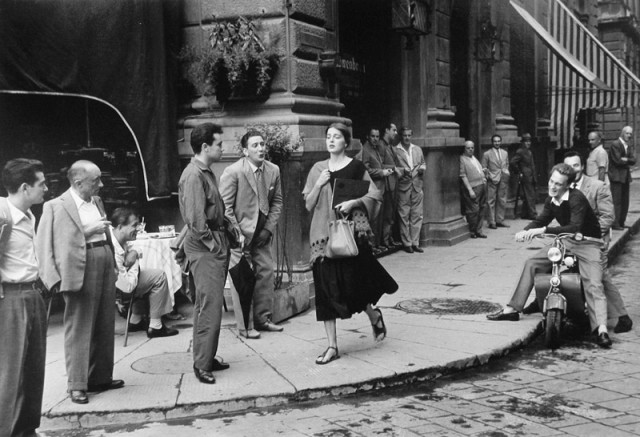(b. 1921, Boston, USA; d.1985, New York City, USA)
Ruth Orkin was the only child of Mary Ruby, a silent movie actress, and Samuel Orkin, a mechanical wizard, and grew up in Hollywood during the heyday of the 1920's and 1930's. She was given a Univex camera when she was 10 and began developing her own photographs at 12. A passionate movie fan, Orkin was an avid autograph hunter, but soon began photographing celebrities instead. At the age of 17, she took a monumental bicycle trip across the country to attend the 1939 World's Fair in New York City. At 21, she became a messenger at MGM Studios, but left because the cinematographer's union did not accept female members.
Orkin moved to New York in 1943. She took baby pictures during the day, and was a nightclub photographer. In the mid-1940's she became a photojournalist for many of the major magazines including Life, Look, Horizon, and Ladies Home Journal. In the late 1940's, she captured classical musicians such as Leonard Bernstein, Isaac Stern, Serge Koussevitzky, Aaron Copland and others during rehearsals at Tanglewood and at Lewisohn Stadium in New York City.
In 1951 Orkin went to Israel with the Israeli Philharmonic, where she lived on a kibbutz for several months and photographed her experiences. She then went to Italy, and it was in Florence where she photographed her signature image "American Girl in Italy." She also traveled through Venice, Paris, Rome and London. Orkin first met PM photographer, Morris Engel at The Photo League, and in 1952 they married while making the classic film, "Little Fugitive." It was nominated for an Academy Award, and won the Silver Lion at the Venice Film Festival. Francois Traffaut has credited the film with starting the New Wave. They went on to make a second award winning film together called "Lovers and Lollipops".
In 1959 Orkin was named one of "The Ten Top Women Photographers in the U.S." along with Dorothea Lange and Margaret Bourke-White by the Professional Photographers of America. Her priorities turned to raising a family, and Orkin used her camera to photograph her two children. First, her son Andy and three years later, her daughter Mary. From her Central Park West apartment, she watched the seasons change outside her window and for the next 30 years documented what she saw. These photographs became the subject for two books "A World Through My Window" (1978) and "More Pictures From My Window" (1983). Her monograph "A Photo Journal" was published in 1981, and exhibitions and lecture tours followed. In 1985, after a long struggle with cancer, Orkin passed away in her apartment surrounded by her wonderful legacy of photographs, and the view of Central Park outside of her window.

